Professional Engineering Practice 11: Electrical Firm Report
VerifiedAdded on 2020/05/16
|12
|3535
|29
Report
AI Summary
This report, focused on professional engineering practice, examines the creation of an electrical organization named Tekhno Rail, which specializes in manufacturing batteries for electric trains. The report covers key aspects such as the company's overview, vision, values, and competitive advantages, including low cost and differentiation strategies. It also explores the role of the firm in society, emphasizing social responsibilities towards customers, employees, and the community. Furthermore, the report details the roles and responsibilities of an electrical engineer, along with relevant laws like contract laws and workplace regulations. It delves into organizational culture, steps for sustaining a quality culture, and strategies for retaining, attracting, and motivating staff and customers. The report concludes with a discussion on leadership and management styles, specifically transformational leadership, and knowledge and skill management within the company. The report also touches upon business ethics and Maori cultural concepts, providing a comprehensive overview of the practical aspects of establishing and managing an electrical engineering firm.
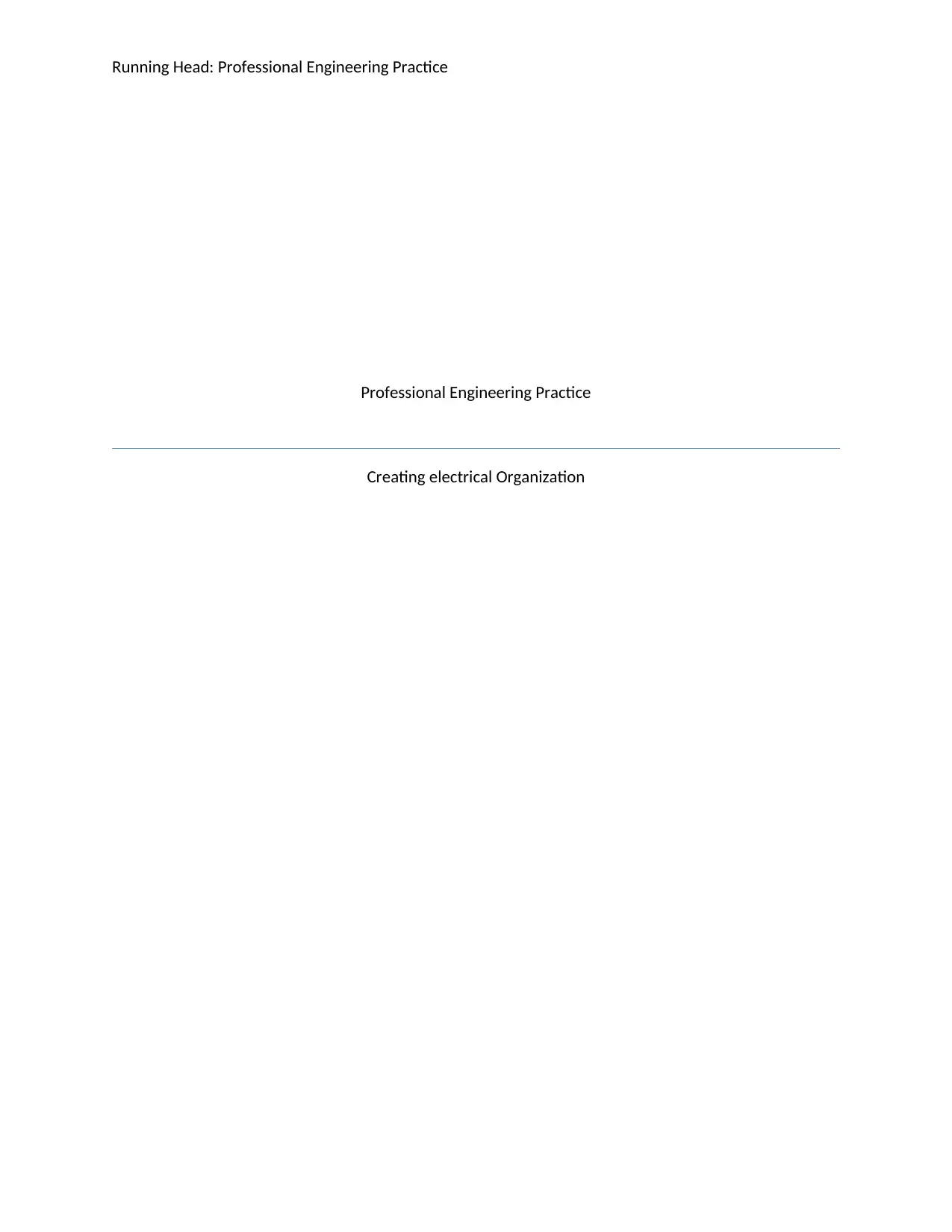
Running Head: Professional Engineering Practice
Professional Engineering Practice
Creating electrical Organization
Professional Engineering Practice
Creating electrical Organization
Paraphrase This Document
Need a fresh take? Get an instant paraphrase of this document with our AI Paraphraser
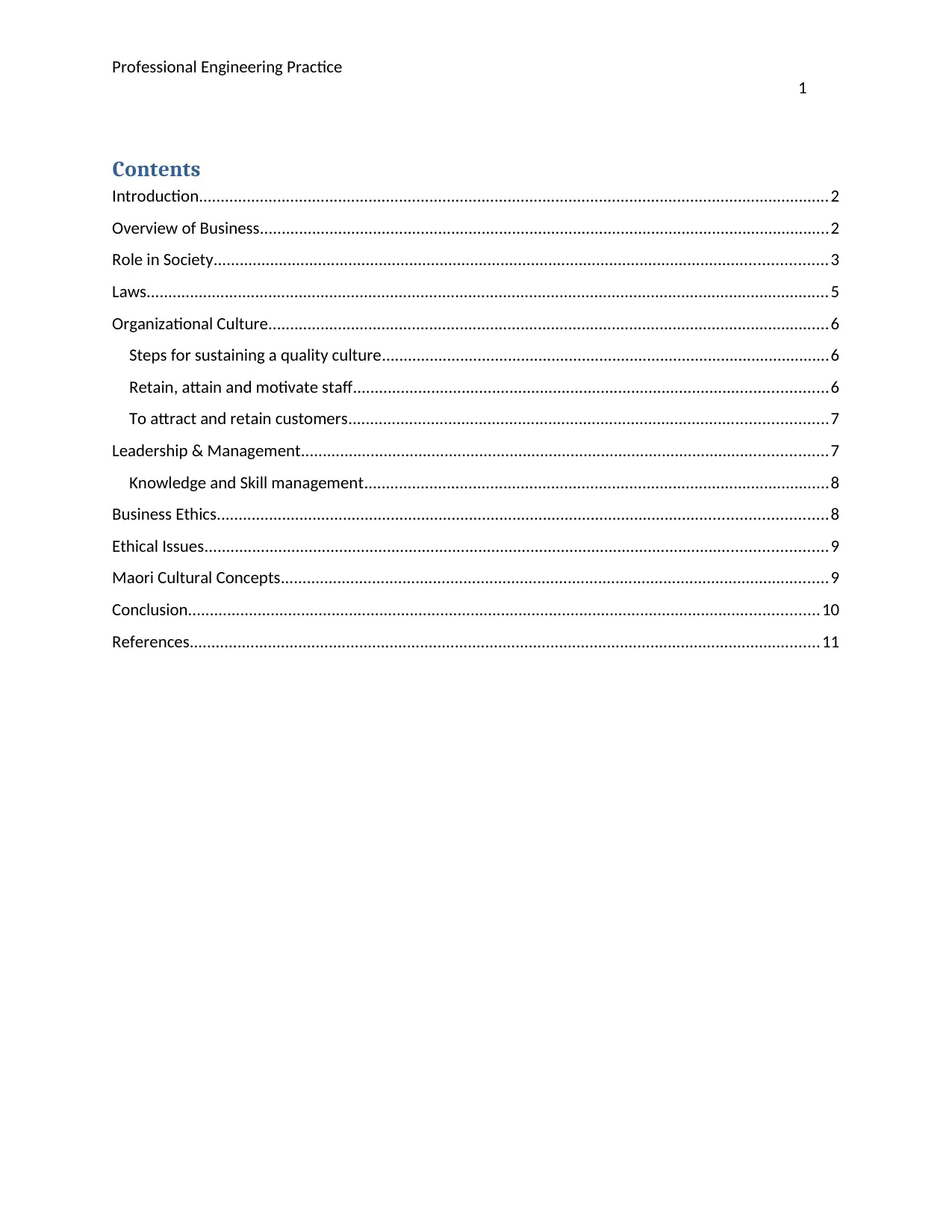
Professional Engineering Practice
1
Contents
Introduction.................................................................................................................................................2
Overview of Business...................................................................................................................................2
Role in Society.............................................................................................................................................3
Laws.............................................................................................................................................................5
Organizational Culture.................................................................................................................................6
Steps for sustaining a quality culture.......................................................................................................6
Retain, attain and motivate staff.............................................................................................................6
To attract and retain customers..............................................................................................................7
Leadership & Management.........................................................................................................................7
Knowledge and Skill management...........................................................................................................8
Business Ethics............................................................................................................................................8
Ethical Issues...............................................................................................................................................9
Maori Cultural Concepts..............................................................................................................................9
Conclusion.................................................................................................................................................10
References.................................................................................................................................................11
1
Contents
Introduction.................................................................................................................................................2
Overview of Business...................................................................................................................................2
Role in Society.............................................................................................................................................3
Laws.............................................................................................................................................................5
Organizational Culture.................................................................................................................................6
Steps for sustaining a quality culture.......................................................................................................6
Retain, attain and motivate staff.............................................................................................................6
To attract and retain customers..............................................................................................................7
Leadership & Management.........................................................................................................................7
Knowledge and Skill management...........................................................................................................8
Business Ethics............................................................................................................................................8
Ethical Issues...............................................................................................................................................9
Maori Cultural Concepts..............................................................................................................................9
Conclusion.................................................................................................................................................10
References.................................................................................................................................................11
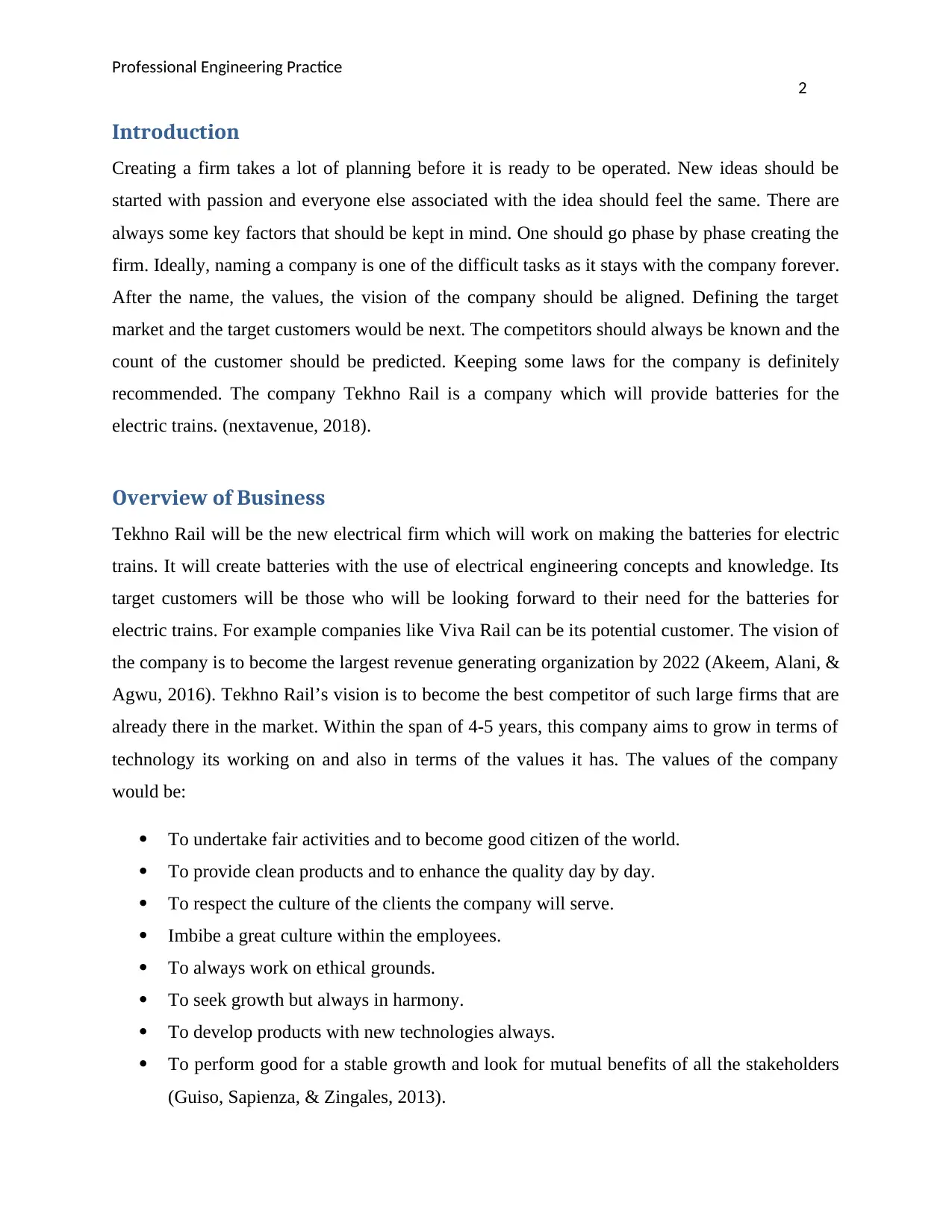
Professional Engineering Practice
2
Introduction
Creating a firm takes a lot of planning before it is ready to be operated. New ideas should be
started with passion and everyone else associated with the idea should feel the same. There are
always some key factors that should be kept in mind. One should go phase by phase creating the
firm. Ideally, naming a company is one of the difficult tasks as it stays with the company forever.
After the name, the values, the vision of the company should be aligned. Defining the target
market and the target customers would be next. The competitors should always be known and the
count of the customer should be predicted. Keeping some laws for the company is definitely
recommended. The company Tekhno Rail is a company which will provide batteries for the
electric trains. (nextavenue, 2018).
Overview of Business
Tekhno Rail will be the new electrical firm which will work on making the batteries for electric
trains. It will create batteries with the use of electrical engineering concepts and knowledge. Its
target customers will be those who will be looking forward to their need for the batteries for
electric trains. For example companies like Viva Rail can be its potential customer. The vision of
the company is to become the largest revenue generating organization by 2022 (Akeem, Alani, &
Agwu, 2016). Tekhno Rail’s vision is to become the best competitor of such large firms that are
already there in the market. Within the span of 4-5 years, this company aims to grow in terms of
technology its working on and also in terms of the values it has. The values of the company
would be:
To undertake fair activities and to become good citizen of the world.
To provide clean products and to enhance the quality day by day.
To respect the culture of the clients the company will serve.
Imbibe a great culture within the employees.
To always work on ethical grounds.
To seek growth but always in harmony.
To develop products with new technologies always.
To perform good for a stable growth and look for mutual benefits of all the stakeholders
(Guiso, Sapienza, & Zingales, 2013).
2
Introduction
Creating a firm takes a lot of planning before it is ready to be operated. New ideas should be
started with passion and everyone else associated with the idea should feel the same. There are
always some key factors that should be kept in mind. One should go phase by phase creating the
firm. Ideally, naming a company is one of the difficult tasks as it stays with the company forever.
After the name, the values, the vision of the company should be aligned. Defining the target
market and the target customers would be next. The competitors should always be known and the
count of the customer should be predicted. Keeping some laws for the company is definitely
recommended. The company Tekhno Rail is a company which will provide batteries for the
electric trains. (nextavenue, 2018).
Overview of Business
Tekhno Rail will be the new electrical firm which will work on making the batteries for electric
trains. It will create batteries with the use of electrical engineering concepts and knowledge. Its
target customers will be those who will be looking forward to their need for the batteries for
electric trains. For example companies like Viva Rail can be its potential customer. The vision of
the company is to become the largest revenue generating organization by 2022 (Akeem, Alani, &
Agwu, 2016). Tekhno Rail’s vision is to become the best competitor of such large firms that are
already there in the market. Within the span of 4-5 years, this company aims to grow in terms of
technology its working on and also in terms of the values it has. The values of the company
would be:
To undertake fair activities and to become good citizen of the world.
To provide clean products and to enhance the quality day by day.
To respect the culture of the clients the company will serve.
Imbibe a great culture within the employees.
To always work on ethical grounds.
To seek growth but always in harmony.
To develop products with new technologies always.
To perform good for a stable growth and look for mutual benefits of all the stakeholders
(Guiso, Sapienza, & Zingales, 2013).
⊘ This is a preview!⊘
Do you want full access?
Subscribe today to unlock all pages.

Trusted by 1+ million students worldwide
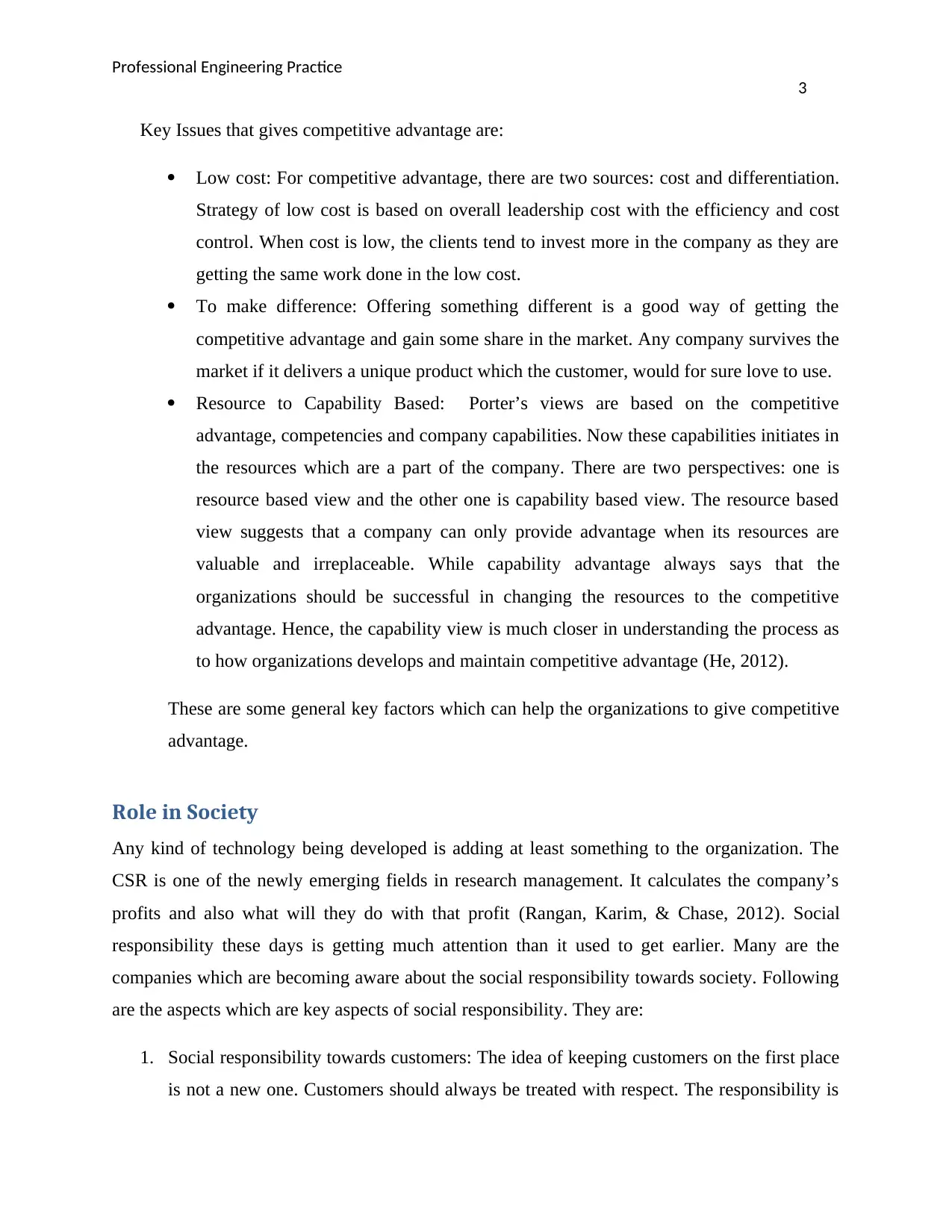
Professional Engineering Practice
3
Key Issues that gives competitive advantage are:
Low cost: For competitive advantage, there are two sources: cost and differentiation.
Strategy of low cost is based on overall leadership cost with the efficiency and cost
control. When cost is low, the clients tend to invest more in the company as they are
getting the same work done in the low cost.
To make difference: Offering something different is a good way of getting the
competitive advantage and gain some share in the market. Any company survives the
market if it delivers a unique product which the customer, would for sure love to use.
Resource to Capability Based: Porter’s views are based on the competitive
advantage, competencies and company capabilities. Now these capabilities initiates in
the resources which are a part of the company. There are two perspectives: one is
resource based view and the other one is capability based view. The resource based
view suggests that a company can only provide advantage when its resources are
valuable and irreplaceable. While capability advantage always says that the
organizations should be successful in changing the resources to the competitive
advantage. Hence, the capability view is much closer in understanding the process as
to how organizations develops and maintain competitive advantage (He, 2012).
These are some general key factors which can help the organizations to give competitive
advantage.
Role in Society
Any kind of technology being developed is adding at least something to the organization. The
CSR is one of the newly emerging fields in research management. It calculates the company’s
profits and also what will they do with that profit (Rangan, Karim, & Chase, 2012). Social
responsibility these days is getting much attention than it used to get earlier. Many are the
companies which are becoming aware about the social responsibility towards society. Following
are the aspects which are key aspects of social responsibility. They are:
1. Social responsibility towards customers: The idea of keeping customers on the first place
is not a new one. Customers should always be treated with respect. The responsibility is
3
Key Issues that gives competitive advantage are:
Low cost: For competitive advantage, there are two sources: cost and differentiation.
Strategy of low cost is based on overall leadership cost with the efficiency and cost
control. When cost is low, the clients tend to invest more in the company as they are
getting the same work done in the low cost.
To make difference: Offering something different is a good way of getting the
competitive advantage and gain some share in the market. Any company survives the
market if it delivers a unique product which the customer, would for sure love to use.
Resource to Capability Based: Porter’s views are based on the competitive
advantage, competencies and company capabilities. Now these capabilities initiates in
the resources which are a part of the company. There are two perspectives: one is
resource based view and the other one is capability based view. The resource based
view suggests that a company can only provide advantage when its resources are
valuable and irreplaceable. While capability advantage always says that the
organizations should be successful in changing the resources to the competitive
advantage. Hence, the capability view is much closer in understanding the process as
to how organizations develops and maintain competitive advantage (He, 2012).
These are some general key factors which can help the organizations to give competitive
advantage.
Role in Society
Any kind of technology being developed is adding at least something to the organization. The
CSR is one of the newly emerging fields in research management. It calculates the company’s
profits and also what will they do with that profit (Rangan, Karim, & Chase, 2012). Social
responsibility these days is getting much attention than it used to get earlier. Many are the
companies which are becoming aware about the social responsibility towards society. Following
are the aspects which are key aspects of social responsibility. They are:
1. Social responsibility towards customers: The idea of keeping customers on the first place
is not a new one. Customers should always be treated with respect. The responsibility is
Paraphrase This Document
Need a fresh take? Get an instant paraphrase of this document with our AI Paraphraser
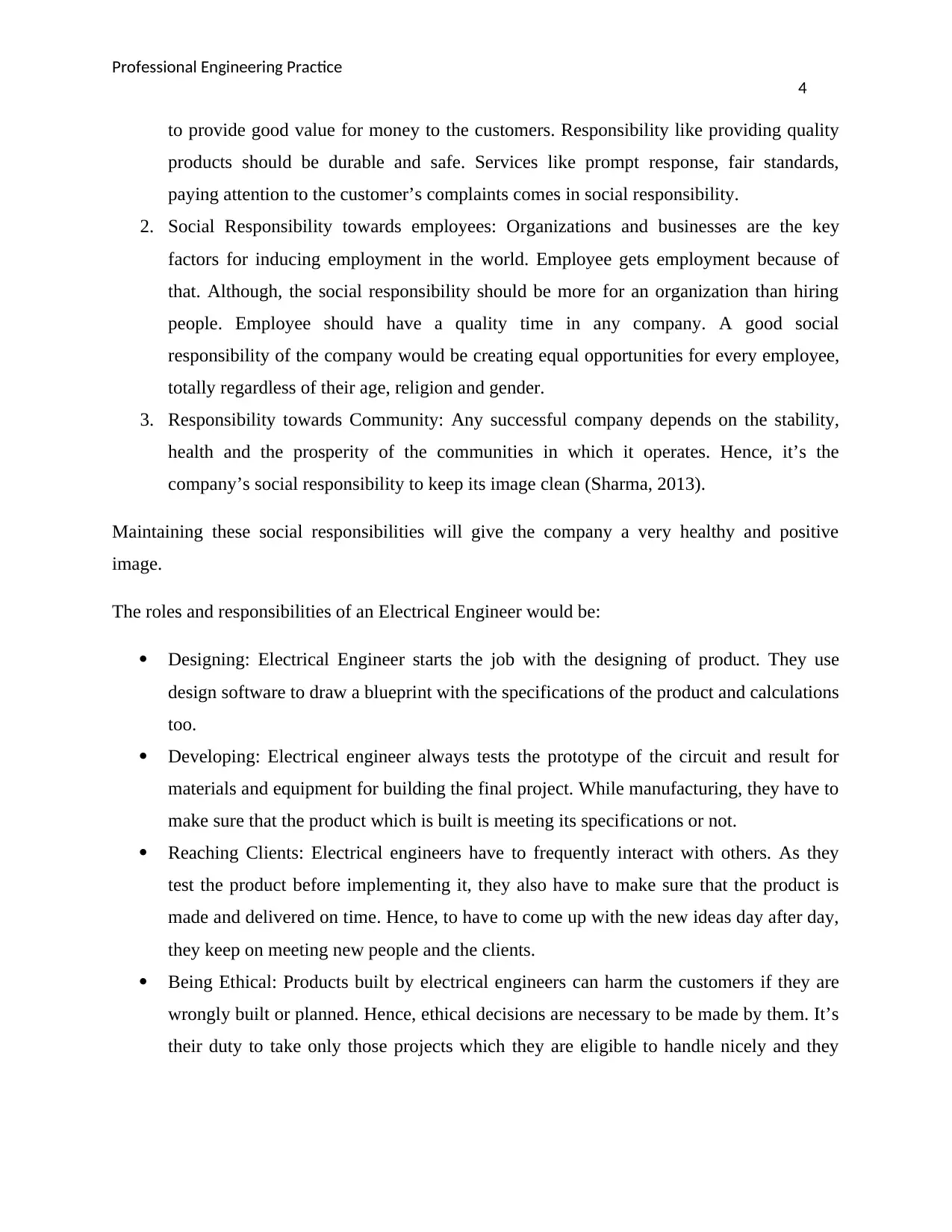
Professional Engineering Practice
4
to provide good value for money to the customers. Responsibility like providing quality
products should be durable and safe. Services like prompt response, fair standards,
paying attention to the customer’s complaints comes in social responsibility.
2. Social Responsibility towards employees: Organizations and businesses are the key
factors for inducing employment in the world. Employee gets employment because of
that. Although, the social responsibility should be more for an organization than hiring
people. Employee should have a quality time in any company. A good social
responsibility of the company would be creating equal opportunities for every employee,
totally regardless of their age, religion and gender.
3. Responsibility towards Community: Any successful company depends on the stability,
health and the prosperity of the communities in which it operates. Hence, it’s the
company’s social responsibility to keep its image clean (Sharma, 2013).
Maintaining these social responsibilities will give the company a very healthy and positive
image.
The roles and responsibilities of an Electrical Engineer would be:
Designing: Electrical Engineer starts the job with the designing of product. They use
design software to draw a blueprint with the specifications of the product and calculations
too.
Developing: Electrical engineer always tests the prototype of the circuit and result for
materials and equipment for building the final project. While manufacturing, they have to
make sure that the product which is built is meeting its specifications or not.
Reaching Clients: Electrical engineers have to frequently interact with others. As they
test the product before implementing it, they also have to make sure that the product is
made and delivered on time. Hence, to have to come up with the new ideas day after day,
they keep on meeting new people and the clients.
Being Ethical: Products built by electrical engineers can harm the customers if they are
wrongly built or planned. Hence, ethical decisions are necessary to be made by them. It’s
their duty to take only those projects which they are eligible to handle nicely and they
4
to provide good value for money to the customers. Responsibility like providing quality
products should be durable and safe. Services like prompt response, fair standards,
paying attention to the customer’s complaints comes in social responsibility.
2. Social Responsibility towards employees: Organizations and businesses are the key
factors for inducing employment in the world. Employee gets employment because of
that. Although, the social responsibility should be more for an organization than hiring
people. Employee should have a quality time in any company. A good social
responsibility of the company would be creating equal opportunities for every employee,
totally regardless of their age, religion and gender.
3. Responsibility towards Community: Any successful company depends on the stability,
health and the prosperity of the communities in which it operates. Hence, it’s the
company’s social responsibility to keep its image clean (Sharma, 2013).
Maintaining these social responsibilities will give the company a very healthy and positive
image.
The roles and responsibilities of an Electrical Engineer would be:
Designing: Electrical Engineer starts the job with the designing of product. They use
design software to draw a blueprint with the specifications of the product and calculations
too.
Developing: Electrical engineer always tests the prototype of the circuit and result for
materials and equipment for building the final project. While manufacturing, they have to
make sure that the product which is built is meeting its specifications or not.
Reaching Clients: Electrical engineers have to frequently interact with others. As they
test the product before implementing it, they also have to make sure that the product is
made and delivered on time. Hence, to have to come up with the new ideas day after day,
they keep on meeting new people and the clients.
Being Ethical: Products built by electrical engineers can harm the customers if they are
wrongly built or planned. Hence, ethical decisions are necessary to be made by them. It’s
their duty to take only those projects which they are eligible to handle nicely and they
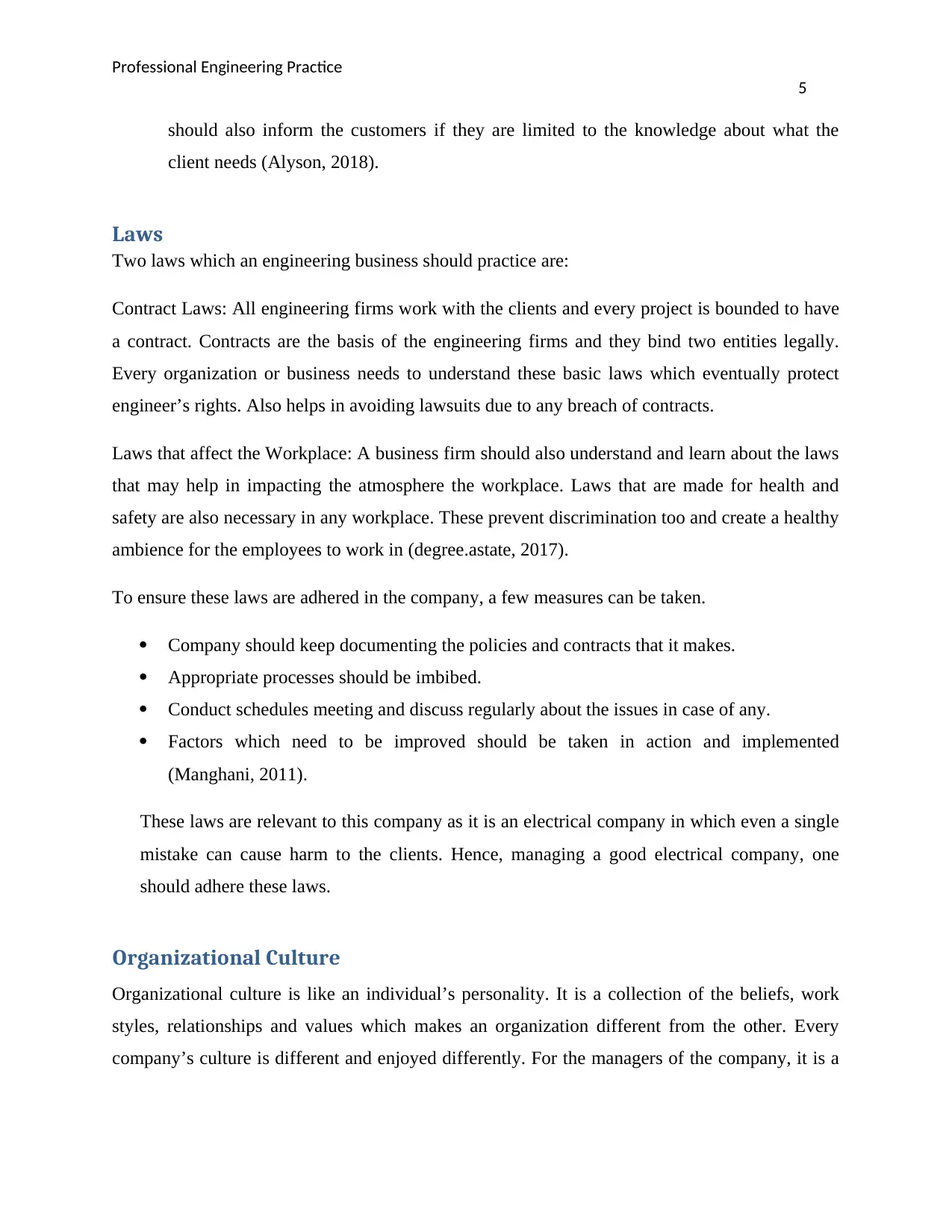
Professional Engineering Practice
5
should also inform the customers if they are limited to the knowledge about what the
client needs (Alyson, 2018).
Laws
Two laws which an engineering business should practice are:
Contract Laws: All engineering firms work with the clients and every project is bounded to have
a contract. Contracts are the basis of the engineering firms and they bind two entities legally.
Every organization or business needs to understand these basic laws which eventually protect
engineer’s rights. Also helps in avoiding lawsuits due to any breach of contracts.
Laws that affect the Workplace: A business firm should also understand and learn about the laws
that may help in impacting the atmosphere the workplace. Laws that are made for health and
safety are also necessary in any workplace. These prevent discrimination too and create a healthy
ambience for the employees to work in (degree.astate, 2017).
To ensure these laws are adhered in the company, a few measures can be taken.
Company should keep documenting the policies and contracts that it makes.
Appropriate processes should be imbibed.
Conduct schedules meeting and discuss regularly about the issues in case of any.
Factors which need to be improved should be taken in action and implemented
(Manghani, 2011).
These laws are relevant to this company as it is an electrical company in which even a single
mistake can cause harm to the clients. Hence, managing a good electrical company, one
should adhere these laws.
Organizational Culture
Organizational culture is like an individual’s personality. It is a collection of the beliefs, work
styles, relationships and values which makes an organization different from the other. Every
company’s culture is different and enjoyed differently. For the managers of the company, it is a
5
should also inform the customers if they are limited to the knowledge about what the
client needs (Alyson, 2018).
Laws
Two laws which an engineering business should practice are:
Contract Laws: All engineering firms work with the clients and every project is bounded to have
a contract. Contracts are the basis of the engineering firms and they bind two entities legally.
Every organization or business needs to understand these basic laws which eventually protect
engineer’s rights. Also helps in avoiding lawsuits due to any breach of contracts.
Laws that affect the Workplace: A business firm should also understand and learn about the laws
that may help in impacting the atmosphere the workplace. Laws that are made for health and
safety are also necessary in any workplace. These prevent discrimination too and create a healthy
ambience for the employees to work in (degree.astate, 2017).
To ensure these laws are adhered in the company, a few measures can be taken.
Company should keep documenting the policies and contracts that it makes.
Appropriate processes should be imbibed.
Conduct schedules meeting and discuss regularly about the issues in case of any.
Factors which need to be improved should be taken in action and implemented
(Manghani, 2011).
These laws are relevant to this company as it is an electrical company in which even a single
mistake can cause harm to the clients. Hence, managing a good electrical company, one
should adhere these laws.
Organizational Culture
Organizational culture is like an individual’s personality. It is a collection of the beliefs, work
styles, relationships and values which makes an organization different from the other. Every
company’s culture is different and enjoyed differently. For the managers of the company, it is a
⊘ This is a preview!⊘
Do you want full access?
Subscribe today to unlock all pages.

Trusted by 1+ million students worldwide
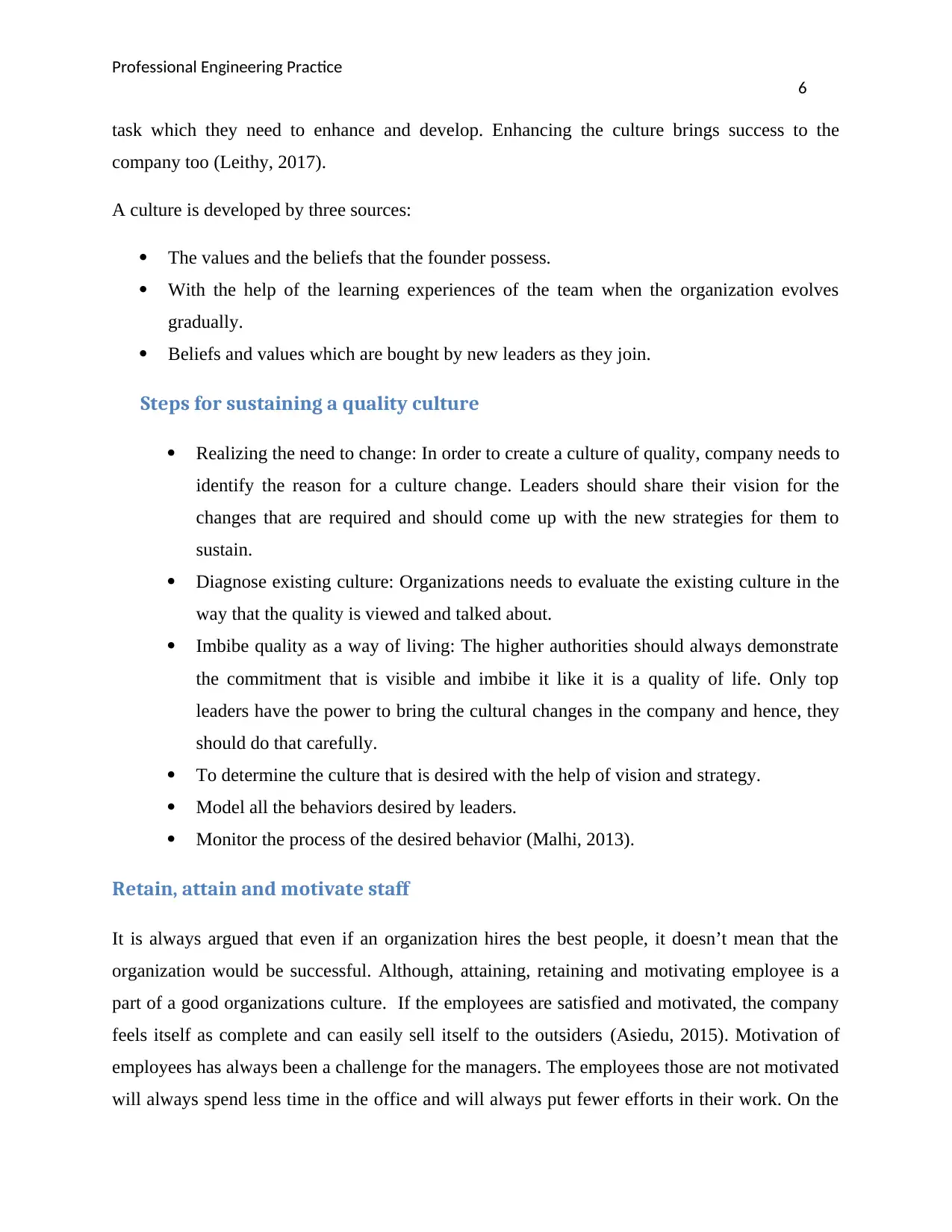
Professional Engineering Practice
6
task which they need to enhance and develop. Enhancing the culture brings success to the
company too (Leithy, 2017).
A culture is developed by three sources:
The values and the beliefs that the founder possess.
With the help of the learning experiences of the team when the organization evolves
gradually.
Beliefs and values which are bought by new leaders as they join.
Steps for sustaining a quality culture
Realizing the need to change: In order to create a culture of quality, company needs to
identify the reason for a culture change. Leaders should share their vision for the
changes that are required and should come up with the new strategies for them to
sustain.
Diagnose existing culture: Organizations needs to evaluate the existing culture in the
way that the quality is viewed and talked about.
Imbibe quality as a way of living: The higher authorities should always demonstrate
the commitment that is visible and imbibe it like it is a quality of life. Only top
leaders have the power to bring the cultural changes in the company and hence, they
should do that carefully.
To determine the culture that is desired with the help of vision and strategy.
Model all the behaviors desired by leaders.
Monitor the process of the desired behavior (Malhi, 2013).
Retain, attain and motivate staff
It is always argued that even if an organization hires the best people, it doesn’t mean that the
organization would be successful. Although, attaining, retaining and motivating employee is a
part of a good organizations culture. If the employees are satisfied and motivated, the company
feels itself as complete and can easily sell itself to the outsiders (Asiedu, 2015). Motivation of
employees has always been a challenge for the managers. The employees those are not motivated
will always spend less time in the office and will always put fewer efforts in their work. On the
6
task which they need to enhance and develop. Enhancing the culture brings success to the
company too (Leithy, 2017).
A culture is developed by three sources:
The values and the beliefs that the founder possess.
With the help of the learning experiences of the team when the organization evolves
gradually.
Beliefs and values which are bought by new leaders as they join.
Steps for sustaining a quality culture
Realizing the need to change: In order to create a culture of quality, company needs to
identify the reason for a culture change. Leaders should share their vision for the
changes that are required and should come up with the new strategies for them to
sustain.
Diagnose existing culture: Organizations needs to evaluate the existing culture in the
way that the quality is viewed and talked about.
Imbibe quality as a way of living: The higher authorities should always demonstrate
the commitment that is visible and imbibe it like it is a quality of life. Only top
leaders have the power to bring the cultural changes in the company and hence, they
should do that carefully.
To determine the culture that is desired with the help of vision and strategy.
Model all the behaviors desired by leaders.
Monitor the process of the desired behavior (Malhi, 2013).
Retain, attain and motivate staff
It is always argued that even if an organization hires the best people, it doesn’t mean that the
organization would be successful. Although, attaining, retaining and motivating employee is a
part of a good organizations culture. If the employees are satisfied and motivated, the company
feels itself as complete and can easily sell itself to the outsiders (Asiedu, 2015). Motivation of
employees has always been a challenge for the managers. The employees those are not motivated
will always spend less time in the office and will always put fewer efforts in their work. On the
Paraphrase This Document
Need a fresh take? Get an instant paraphrase of this document with our AI Paraphraser
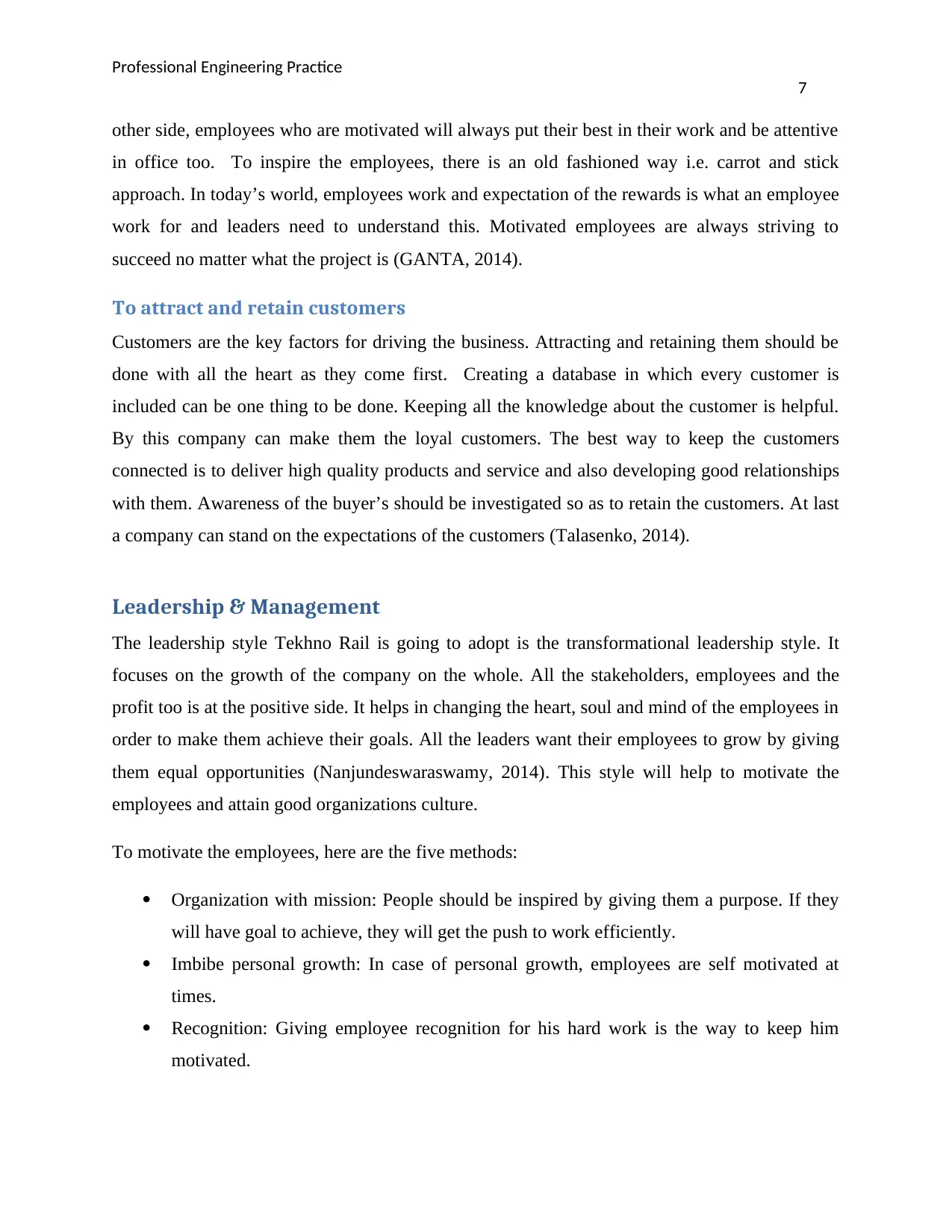
Professional Engineering Practice
7
other side, employees who are motivated will always put their best in their work and be attentive
in office too. To inspire the employees, there is an old fashioned way i.e. carrot and stick
approach. In today’s world, employees work and expectation of the rewards is what an employee
work for and leaders need to understand this. Motivated employees are always striving to
succeed no matter what the project is (GANTA, 2014).
To attract and retain customers
Customers are the key factors for driving the business. Attracting and retaining them should be
done with all the heart as they come first. Creating a database in which every customer is
included can be one thing to be done. Keeping all the knowledge about the customer is helpful.
By this company can make them the loyal customers. The best way to keep the customers
connected is to deliver high quality products and service and also developing good relationships
with them. Awareness of the buyer’s should be investigated so as to retain the customers. At last
a company can stand on the expectations of the customers (Talasenko, 2014).
Leadership & Management
The leadership style Tekhno Rail is going to adopt is the transformational leadership style. It
focuses on the growth of the company on the whole. All the stakeholders, employees and the
profit too is at the positive side. It helps in changing the heart, soul and mind of the employees in
order to make them achieve their goals. All the leaders want their employees to grow by giving
them equal opportunities (Nanjundeswaraswamy, 2014). This style will help to motivate the
employees and attain good organizations culture.
To motivate the employees, here are the five methods:
Organization with mission: People should be inspired by giving them a purpose. If they
will have goal to achieve, they will get the push to work efficiently.
Imbibe personal growth: In case of personal growth, employees are self motivated at
times.
Recognition: Giving employee recognition for his hard work is the way to keep him
motivated.
7
other side, employees who are motivated will always put their best in their work and be attentive
in office too. To inspire the employees, there is an old fashioned way i.e. carrot and stick
approach. In today’s world, employees work and expectation of the rewards is what an employee
work for and leaders need to understand this. Motivated employees are always striving to
succeed no matter what the project is (GANTA, 2014).
To attract and retain customers
Customers are the key factors for driving the business. Attracting and retaining them should be
done with all the heart as they come first. Creating a database in which every customer is
included can be one thing to be done. Keeping all the knowledge about the customer is helpful.
By this company can make them the loyal customers. The best way to keep the customers
connected is to deliver high quality products and service and also developing good relationships
with them. Awareness of the buyer’s should be investigated so as to retain the customers. At last
a company can stand on the expectations of the customers (Talasenko, 2014).
Leadership & Management
The leadership style Tekhno Rail is going to adopt is the transformational leadership style. It
focuses on the growth of the company on the whole. All the stakeholders, employees and the
profit too is at the positive side. It helps in changing the heart, soul and mind of the employees in
order to make them achieve their goals. All the leaders want their employees to grow by giving
them equal opportunities (Nanjundeswaraswamy, 2014). This style will help to motivate the
employees and attain good organizations culture.
To motivate the employees, here are the five methods:
Organization with mission: People should be inspired by giving them a purpose. If they
will have goal to achieve, they will get the push to work efficiently.
Imbibe personal growth: In case of personal growth, employees are self motivated at
times.
Recognition: Giving employee recognition for his hard work is the way to keep him
motivated.
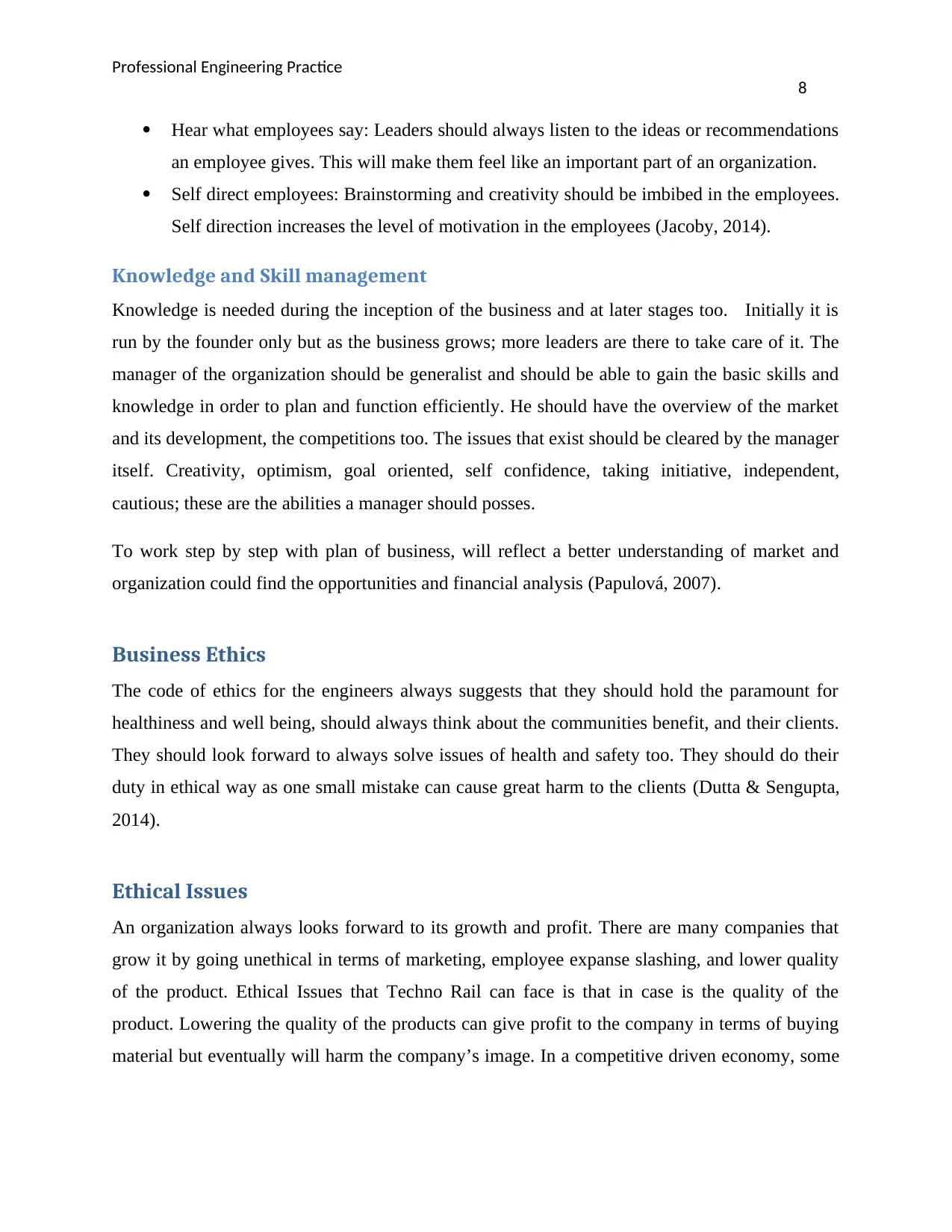
Professional Engineering Practice
8
Hear what employees say: Leaders should always listen to the ideas or recommendations
an employee gives. This will make them feel like an important part of an organization.
Self direct employees: Brainstorming and creativity should be imbibed in the employees.
Self direction increases the level of motivation in the employees (Jacoby, 2014).
Knowledge and Skill management
Knowledge is needed during the inception of the business and at later stages too. Initially it is
run by the founder only but as the business grows; more leaders are there to take care of it. The
manager of the organization should be generalist and should be able to gain the basic skills and
knowledge in order to plan and function efficiently. He should have the overview of the market
and its development, the competitions too. The issues that exist should be cleared by the manager
itself. Creativity, optimism, goal oriented, self confidence, taking initiative, independent,
cautious; these are the abilities a manager should posses.
To work step by step with plan of business, will reflect a better understanding of market and
organization could find the opportunities and financial analysis (Papulová, 2007).
Business Ethics
The code of ethics for the engineers always suggests that they should hold the paramount for
healthiness and well being, should always think about the communities benefit, and their clients.
They should look forward to always solve issues of health and safety too. They should do their
duty in ethical way as one small mistake can cause great harm to the clients (Dutta & Sengupta,
2014).
Ethical Issues
An organization always looks forward to its growth and profit. There are many companies that
grow it by going unethical in terms of marketing, employee expanse slashing, and lower quality
of the product. Ethical Issues that Techno Rail can face is that in case is the quality of the
product. Lowering the quality of the products can give profit to the company in terms of buying
material but eventually will harm the company’s image. In a competitive driven economy, some
8
Hear what employees say: Leaders should always listen to the ideas or recommendations
an employee gives. This will make them feel like an important part of an organization.
Self direct employees: Brainstorming and creativity should be imbibed in the employees.
Self direction increases the level of motivation in the employees (Jacoby, 2014).
Knowledge and Skill management
Knowledge is needed during the inception of the business and at later stages too. Initially it is
run by the founder only but as the business grows; more leaders are there to take care of it. The
manager of the organization should be generalist and should be able to gain the basic skills and
knowledge in order to plan and function efficiently. He should have the overview of the market
and its development, the competitions too. The issues that exist should be cleared by the manager
itself. Creativity, optimism, goal oriented, self confidence, taking initiative, independent,
cautious; these are the abilities a manager should posses.
To work step by step with plan of business, will reflect a better understanding of market and
organization could find the opportunities and financial analysis (Papulová, 2007).
Business Ethics
The code of ethics for the engineers always suggests that they should hold the paramount for
healthiness and well being, should always think about the communities benefit, and their clients.
They should look forward to always solve issues of health and safety too. They should do their
duty in ethical way as one small mistake can cause great harm to the clients (Dutta & Sengupta,
2014).
Ethical Issues
An organization always looks forward to its growth and profit. There are many companies that
grow it by going unethical in terms of marketing, employee expanse slashing, and lower quality
of the product. Ethical Issues that Techno Rail can face is that in case is the quality of the
product. Lowering the quality of the products can give profit to the company in terms of buying
material but eventually will harm the company’s image. In a competitive driven economy, some
⊘ This is a preview!⊘
Do you want full access?
Subscribe today to unlock all pages.

Trusted by 1+ million students worldwide
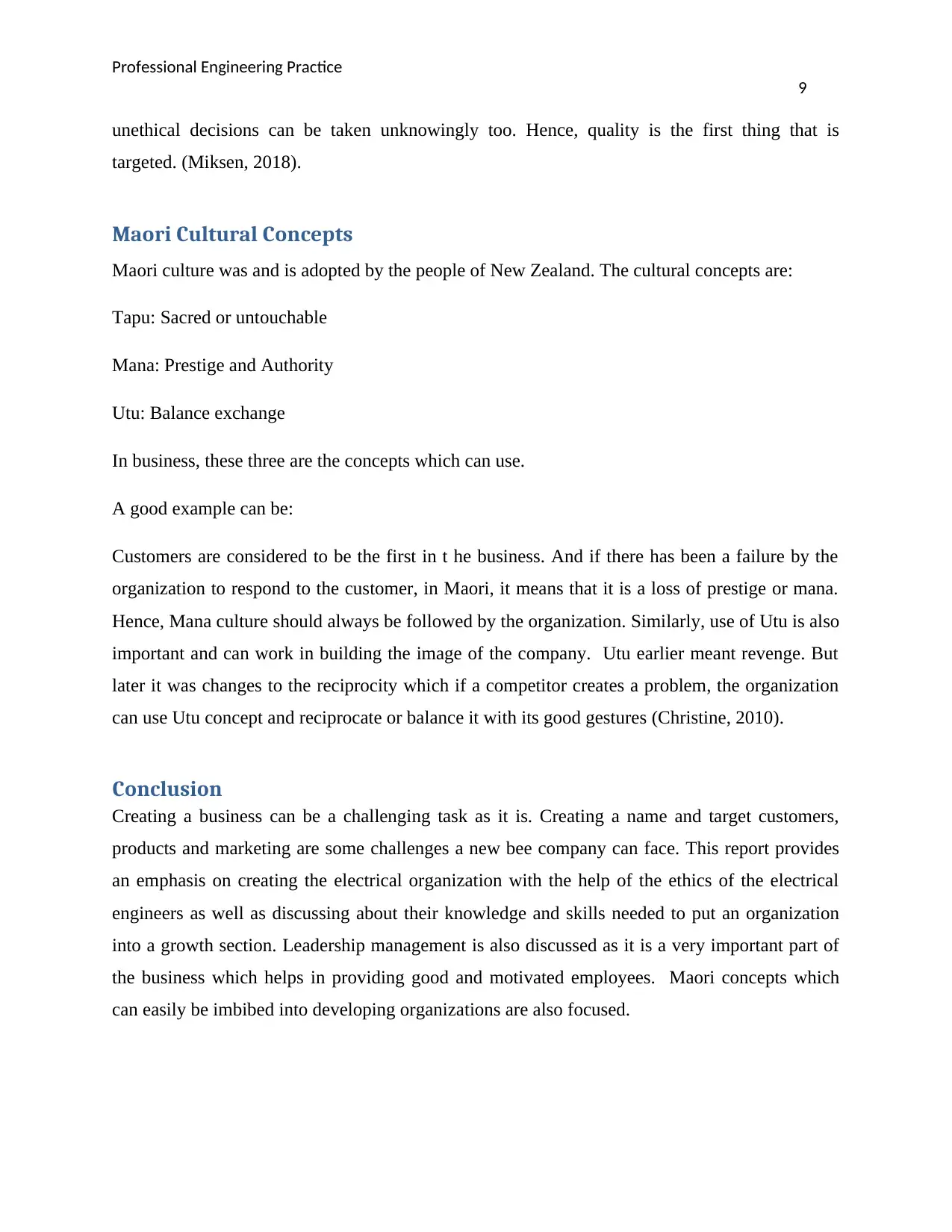
Professional Engineering Practice
9
unethical decisions can be taken unknowingly too. Hence, quality is the first thing that is
targeted. (Miksen, 2018).
Maori Cultural Concepts
Maori culture was and is adopted by the people of New Zealand. The cultural concepts are:
Tapu: Sacred or untouchable
Mana: Prestige and Authority
Utu: Balance exchange
In business, these three are the concepts which can use.
A good example can be:
Customers are considered to be the first in t he business. And if there has been a failure by the
organization to respond to the customer, in Maori, it means that it is a loss of prestige or mana.
Hence, Mana culture should always be followed by the organization. Similarly, use of Utu is also
important and can work in building the image of the company. Utu earlier meant revenge. But
later it was changes to the reciprocity which if a competitor creates a problem, the organization
can use Utu concept and reciprocate or balance it with its good gestures (Christine, 2010).
Conclusion
Creating a business can be a challenging task as it is. Creating a name and target customers,
products and marketing are some challenges a new bee company can face. This report provides
an emphasis on creating the electrical organization with the help of the ethics of the electrical
engineers as well as discussing about their knowledge and skills needed to put an organization
into a growth section. Leadership management is also discussed as it is a very important part of
the business which helps in providing good and motivated employees. Maori concepts which
can easily be imbibed into developing organizations are also focused.
9
unethical decisions can be taken unknowingly too. Hence, quality is the first thing that is
targeted. (Miksen, 2018).
Maori Cultural Concepts
Maori culture was and is adopted by the people of New Zealand. The cultural concepts are:
Tapu: Sacred or untouchable
Mana: Prestige and Authority
Utu: Balance exchange
In business, these three are the concepts which can use.
A good example can be:
Customers are considered to be the first in t he business. And if there has been a failure by the
organization to respond to the customer, in Maori, it means that it is a loss of prestige or mana.
Hence, Mana culture should always be followed by the organization. Similarly, use of Utu is also
important and can work in building the image of the company. Utu earlier meant revenge. But
later it was changes to the reciprocity which if a competitor creates a problem, the organization
can use Utu concept and reciprocate or balance it with its good gestures (Christine, 2010).
Conclusion
Creating a business can be a challenging task as it is. Creating a name and target customers,
products and marketing are some challenges a new bee company can face. This report provides
an emphasis on creating the electrical organization with the help of the ethics of the electrical
engineers as well as discussing about their knowledge and skills needed to put an organization
into a growth section. Leadership management is also discussed as it is a very important part of
the business which helps in providing good and motivated employees. Maori concepts which
can easily be imbibed into developing organizations are also focused.
Paraphrase This Document
Need a fresh take? Get an instant paraphrase of this document with our AI Paraphraser
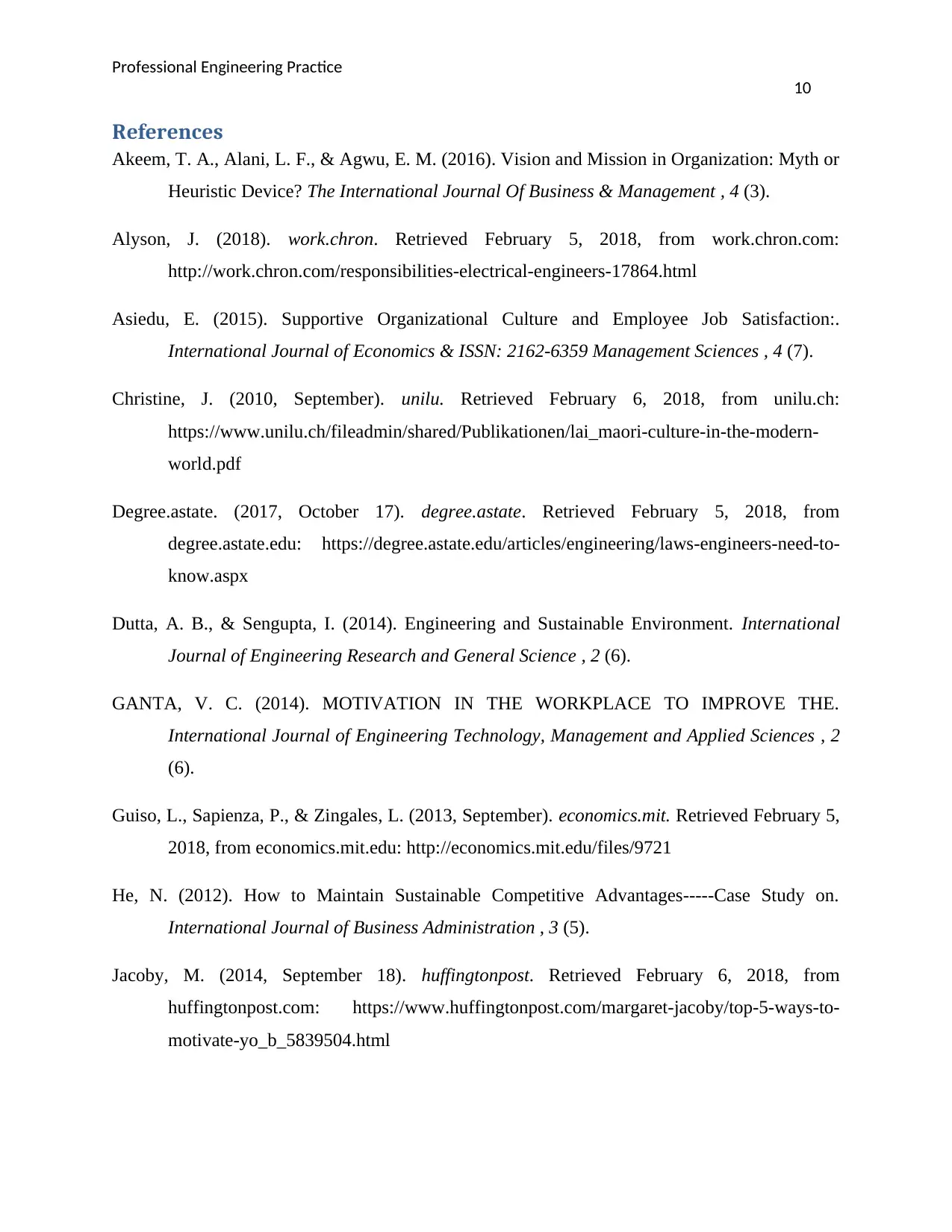
Professional Engineering Practice
10
References
Akeem, T. A., Alani, L. F., & Agwu, E. M. (2016). Vision and Mission in Organization: Myth or
Heuristic Device? The International Journal Of Business & Management , 4 (3).
Alyson, J. (2018). work.chron. Retrieved February 5, 2018, from work.chron.com:
http://work.chron.com/responsibilities-electrical-engineers-17864.html
Asiedu, E. (2015). Supportive Organizational Culture and Employee Job Satisfaction:.
International Journal of Economics & ISSN: 2162-6359 Management Sciences , 4 (7).
Christine, J. (2010, September). unilu. Retrieved February 6, 2018, from unilu.ch:
https://www.unilu.ch/fileadmin/shared/Publikationen/lai_maori-culture-in-the-modern-
world.pdf
Degree.astate. (2017, October 17). degree.astate. Retrieved February 5, 2018, from
degree.astate.edu: https://degree.astate.edu/articles/engineering/laws-engineers-need-to-
know.aspx
Dutta, A. B., & Sengupta, I. (2014). Engineering and Sustainable Environment. International
Journal of Engineering Research and General Science , 2 (6).
GANTA, V. C. (2014). MOTIVATION IN THE WORKPLACE TO IMPROVE THE.
International Journal of Engineering Technology, Management and Applied Sciences , 2
(6).
Guiso, L., Sapienza, P., & Zingales, L. (2013, September). economics.mit. Retrieved February 5,
2018, from economics.mit.edu: http://economics.mit.edu/files/9721
He, N. (2012). How to Maintain Sustainable Competitive Advantages-----Case Study on.
International Journal of Business Administration , 3 (5).
Jacoby, M. (2014, September 18). huffingtonpost. Retrieved February 6, 2018, from
huffingtonpost.com: https://www.huffingtonpost.com/margaret-jacoby/top-5-ways-to-
motivate-yo_b_5839504.html
10
References
Akeem, T. A., Alani, L. F., & Agwu, E. M. (2016). Vision and Mission in Organization: Myth or
Heuristic Device? The International Journal Of Business & Management , 4 (3).
Alyson, J. (2018). work.chron. Retrieved February 5, 2018, from work.chron.com:
http://work.chron.com/responsibilities-electrical-engineers-17864.html
Asiedu, E. (2015). Supportive Organizational Culture and Employee Job Satisfaction:.
International Journal of Economics & ISSN: 2162-6359 Management Sciences , 4 (7).
Christine, J. (2010, September). unilu. Retrieved February 6, 2018, from unilu.ch:
https://www.unilu.ch/fileadmin/shared/Publikationen/lai_maori-culture-in-the-modern-
world.pdf
Degree.astate. (2017, October 17). degree.astate. Retrieved February 5, 2018, from
degree.astate.edu: https://degree.astate.edu/articles/engineering/laws-engineers-need-to-
know.aspx
Dutta, A. B., & Sengupta, I. (2014). Engineering and Sustainable Environment. International
Journal of Engineering Research and General Science , 2 (6).
GANTA, V. C. (2014). MOTIVATION IN THE WORKPLACE TO IMPROVE THE.
International Journal of Engineering Technology, Management and Applied Sciences , 2
(6).
Guiso, L., Sapienza, P., & Zingales, L. (2013, September). economics.mit. Retrieved February 5,
2018, from economics.mit.edu: http://economics.mit.edu/files/9721
He, N. (2012). How to Maintain Sustainable Competitive Advantages-----Case Study on.
International Journal of Business Administration , 3 (5).
Jacoby, M. (2014, September 18). huffingtonpost. Retrieved February 6, 2018, from
huffingtonpost.com: https://www.huffingtonpost.com/margaret-jacoby/top-5-ways-to-
motivate-yo_b_5839504.html
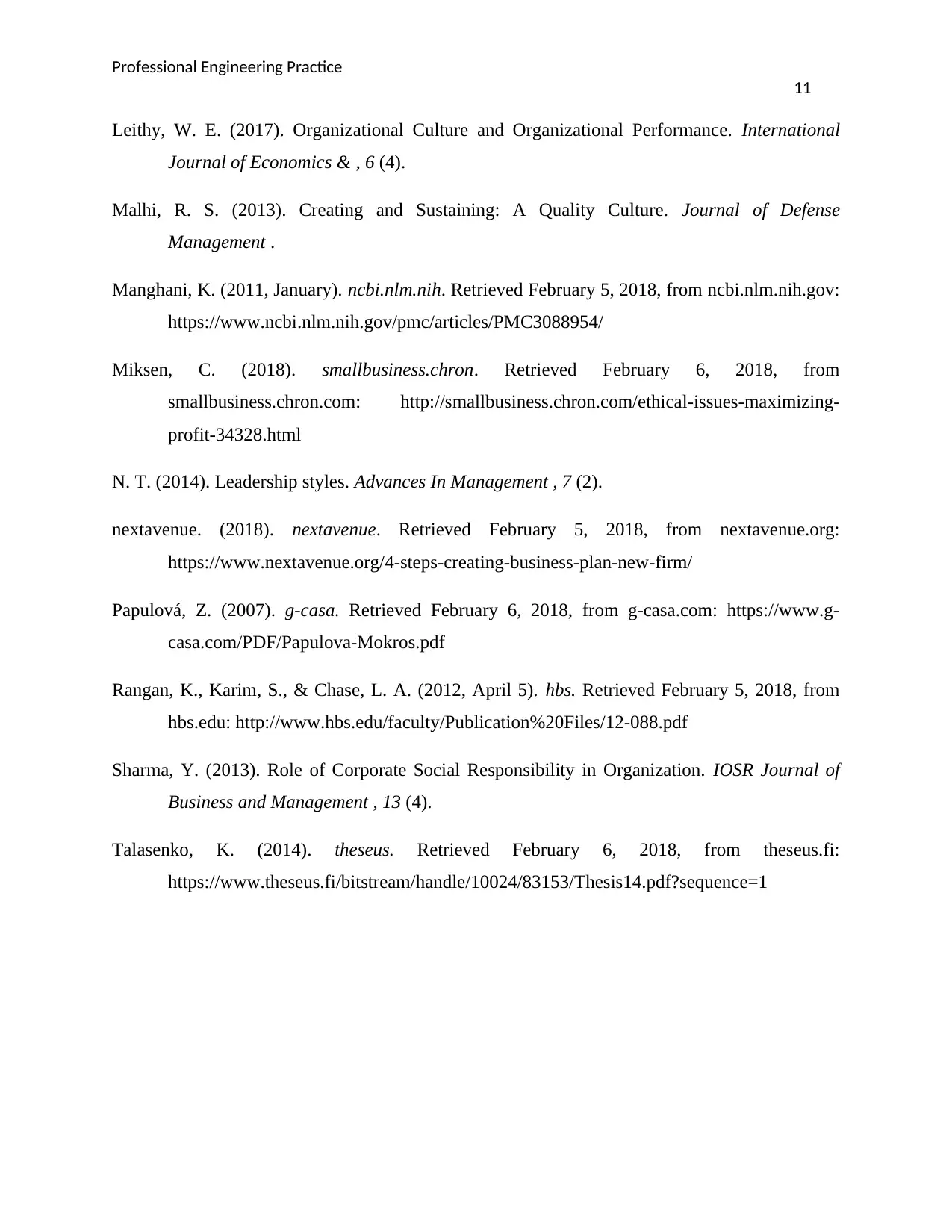
Professional Engineering Practice
11
Leithy, W. E. (2017). Organizational Culture and Organizational Performance. International
Journal of Economics & , 6 (4).
Malhi, R. S. (2013). Creating and Sustaining: A Quality Culture. Journal of Defense
Management .
Manghani, K. (2011, January). ncbi.nlm.nih. Retrieved February 5, 2018, from ncbi.nlm.nih.gov:
https://www.ncbi.nlm.nih.gov/pmc/articles/PMC3088954/
Miksen, C. (2018). smallbusiness.chron. Retrieved February 6, 2018, from
smallbusiness.chron.com: http://smallbusiness.chron.com/ethical-issues-maximizing-
profit-34328.html
N. T. (2014). Leadership styles. Advances In Management , 7 (2).
nextavenue. (2018). nextavenue. Retrieved February 5, 2018, from nextavenue.org:
https://www.nextavenue.org/4-steps-creating-business-plan-new-firm/
Papulová, Z. (2007). g-casa. Retrieved February 6, 2018, from g-casa.com: https://www.g-
casa.com/PDF/Papulova-Mokros.pdf
Rangan, K., Karim, S., & Chase, L. A. (2012, April 5). hbs. Retrieved February 5, 2018, from
hbs.edu: http://www.hbs.edu/faculty/Publication%20Files/12-088.pdf
Sharma, Y. (2013). Role of Corporate Social Responsibility in Organization. IOSR Journal of
Business and Management , 13 (4).
Talasenko, K. (2014). theseus. Retrieved February 6, 2018, from theseus.fi:
https://www.theseus.fi/bitstream/handle/10024/83153/Thesis14.pdf?sequence=1
11
Leithy, W. E. (2017). Organizational Culture and Organizational Performance. International
Journal of Economics & , 6 (4).
Malhi, R. S. (2013). Creating and Sustaining: A Quality Culture. Journal of Defense
Management .
Manghani, K. (2011, January). ncbi.nlm.nih. Retrieved February 5, 2018, from ncbi.nlm.nih.gov:
https://www.ncbi.nlm.nih.gov/pmc/articles/PMC3088954/
Miksen, C. (2018). smallbusiness.chron. Retrieved February 6, 2018, from
smallbusiness.chron.com: http://smallbusiness.chron.com/ethical-issues-maximizing-
profit-34328.html
N. T. (2014). Leadership styles. Advances In Management , 7 (2).
nextavenue. (2018). nextavenue. Retrieved February 5, 2018, from nextavenue.org:
https://www.nextavenue.org/4-steps-creating-business-plan-new-firm/
Papulová, Z. (2007). g-casa. Retrieved February 6, 2018, from g-casa.com: https://www.g-
casa.com/PDF/Papulova-Mokros.pdf
Rangan, K., Karim, S., & Chase, L. A. (2012, April 5). hbs. Retrieved February 5, 2018, from
hbs.edu: http://www.hbs.edu/faculty/Publication%20Files/12-088.pdf
Sharma, Y. (2013). Role of Corporate Social Responsibility in Organization. IOSR Journal of
Business and Management , 13 (4).
Talasenko, K. (2014). theseus. Retrieved February 6, 2018, from theseus.fi:
https://www.theseus.fi/bitstream/handle/10024/83153/Thesis14.pdf?sequence=1
⊘ This is a preview!⊘
Do you want full access?
Subscribe today to unlock all pages.

Trusted by 1+ million students worldwide
1 out of 12
Related Documents
Your All-in-One AI-Powered Toolkit for Academic Success.
+13062052269
info@desklib.com
Available 24*7 on WhatsApp / Email
![[object Object]](/_next/static/media/star-bottom.7253800d.svg)
Unlock your academic potential
Copyright © 2020–2025 A2Z Services. All Rights Reserved. Developed and managed by ZUCOL.




